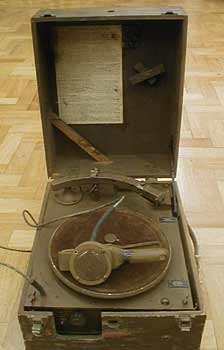
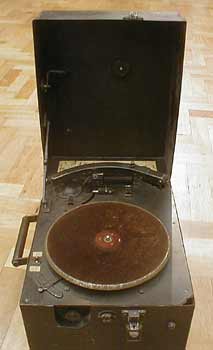
The RDP/1A version on the right carries the serial number 142. This version used a wooden case, to save weight.
A total of seventy-two of the machines were made; numbering started at 101.
The midget disc recorder, or 'Riverside Portable', used double-sided 10-in, discs. Its turntable was driven by a double-spring gramophone motor. The winding handles were a fixed type on the RDP/1 and a more sophisticated folding type on the RDP/1A - sadly they are missing on the photographed machines. The machines looked rather like the black portable gramophones very popular in the 1930s and often taken on picnics - hence the name.
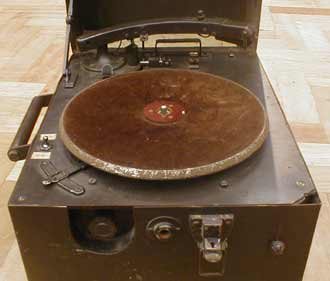
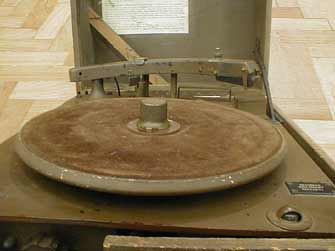
In the autumn one of these recorders was turned over to Research Department for them to produce an improved version.
In just three months a prototype of what became the Mark 1A was produced. The design had been very well thought out and the commentators in the War Reporting Unit were impressed by it.
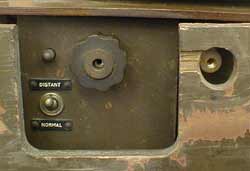
A flickering neon lamp indicated when the level was right for recording, and another warning light showed when there was only fifteen seconds of recording time left.
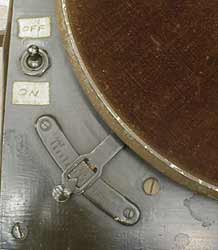
The amplifier incorporated a limiter so there was no need for a level control. The recorder weighed 35-40 lb. complete with its batteries. As mentioned above, the original six machines had steel cases but all the later RDP/1As had wooden cases. These proved to be strong enough and made the machine six pounds lighter. Storage space for a dozen double-sided discs was provided in the lid - slightly more in the 1As. At just under three minutes per side, that gave more than an hour's recording.
Power requirements were modest: 0.3 amp at 3 volts and between 8 and 12 mA at 100 volts, derived from dry batteries housed in a light metal cassette. About forty discs could be recorded before the batteries needed changing. In order to replace the batteries, the RDP/1 had to be turned upside down and four screws removed from the base - hardly convenient when under fire. On the 1A the deck could be removed. It was held in place by wing nuts, making access to the batteries much faster.
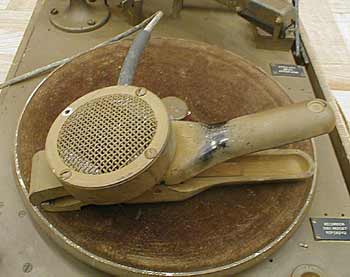
There was concern over the variable quality of these microphones, however the benefit of their relatively high output level outweighed the quality factor.
The early machines had a socket for the microphone on the side of the recorder, later ones had a hard-wired mic.
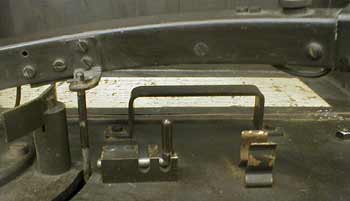
The arm locking catch and swarf brush clamp on the Mark 1. The recording head was a modified crystal pick-up. There was, of course, no way of monitoring a recording.
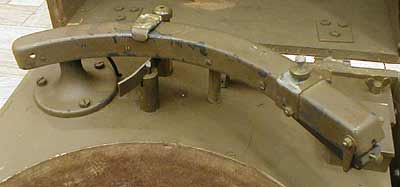
RDP/1As had a more sophisticated traversing mechanism using a buttress thread as opposed to the RDP/1s which just used an ordinary piece of threaded bar.
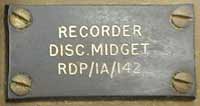
Affixed to the inside of the lid was a page of operational instructions (this version is for the 1A machine and is dated 5/5/44):
Setting Up and Operation
The equipment should be handed over to the commentator ready for field service, complete with discs, batteries, cutter head, microphone and sapphires, one of which should be inserted into the cutter head.
The sequence of operations to make a recording will be as follows.
- Place case in a reasonably horizontal position and remove winding handle
from its folded position.
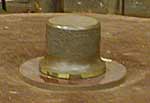
- Release clasps and open lid to its vertical position.
- Clear wire off machine.
- Place and clamp disc on turntable. (Clamp shown right)
- Check that the spring motor is fully wound.
- Release cutter arm and set cutter point about ¼" in from edge of disc.
- Set the attenuator switch to "normal" or "distant" as required (see note below).
- Remove microphone from its holder in lid.
- Turn knob slowly clockwise; the first part of the rotation will switch on the amplifier, & continued rotation will release the motor brake & lower the cutter head on to the disc. This operation should be done carefully to avoid bringing the sapphire down on the disc too violently, which will chip the point.
- The duration of the cut is approximately 3 minutes, & a warning light shows in the front of the equipment fifteen to twenty seconds before the mechanism is tripped by the cutter head reaching the innermost limit of its traverse. The auto trip switches off the amplifier and stops the motor as well as raising the cutter head and releasing the traverse.
- If desired a series of bands may be cut on the disc by pressing the trip button on the front panel when a band is finished. The next band can be commenced by repeating operation (9).
- Re-wind motor ready for next disc.
Note on Use of "Normal/Distant" switch.
This switch in the "Normal" position inserts a 20db attenuator between the microphone & the amplifier. The "Normal" setting should be used when speaking at eighteen inches or less from the microphone. The "Distant" setting should be used when speaking at distance over eighteen inches, & an adequate recording level on the disc will then be obtained up to four feet. For intermediate distances the level is kept within limits by an internal automatic volume control. The "Distant" setting is not recommended for use indoors as the room reverberations & background noises may become obtrusive.
Preparation of Discs
Provision is made in the lid for fifteen to eighteen discs, & these should be wiped over with antistatic fluid before leaving base. This treatment remains effective up to twenty-four hours, after which a further application will probably be necessary.
Batteries
The batteries are contained in a battery box, & a spare box complete with batteries is supplied with each equipment. It is estimated that after cutting about forty to fifty discs the batteries will need replacement. Both L.T. & H.T. batteries will need replacement at the same time. The H.T. battery consists of three Drydex X81's, & the L.T. battery consists of two Siemens S size cells per equipment. Note: When changing batteries the terminal cover must be transferred from the battery box being put into use to that being taken out of use.
Neon Indicator
This device is fitted to give indication that signal is reaching the cutter head. With the switch "Normal" the neon will flash on loud passages of speech and with switch "Distant" it will also flash on heavier background noises.
A document issued by the War Reporting Unit listed
midget recorders issued as of 14/7/44.
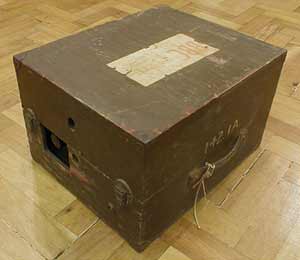
Midget Recorders, RDP/1
101 C.B.C.
102 Richard North - Navy
103 Colin Wills - France
104 F/Lt Caverhill - France
105 Stanley Maxted - Navy
106 Maida Vale Stores - ready for service.
Midget Recorders, RDP/1A
108 Experimental work - Maida Vale Test Room
109 Sarney (an engineer) - France
110 Robin Duff - France
111 A/Cdre. Helmore
112 Lost with Kent Stevenson (who was killed while flying on a Lancaster raid, June 1944)
113 Stewart MacPherson - France
114 At Maida Vale - cutter head faulty
115 Sarney - reserve machine en route for France
116 Colin Wills - France
117 At Maida Vale - cutter head faulty
118 Chester Wilmot - France
119 Pierre LeFevre - France
120 ex C. Fletcher - returned to Maida Vale
121 Robert Reid ??
122 David Bernard ??
123 ex David Bernard - returned to Maida Vale for service
124 Michael Standing - Navy
125 Douglas (?) Willis - Merchant Navy
126 At Maida Vale - ready for service
127 At Farnborough
128 At Maida Vale
No mention is made of 107.
The company which made the midgets was Marguerite Sound Studios. It was founded around 1930 by Cecil Watts and became the MSS Recording Company in 1933, the same year in which Watts's association with the BBC started. His experiments led to the introduction of the "Direct Cut Acetate", using an aluminium disc onto which was coated a cellulose nitrate lacquer. This, though soft enough to cut, was hard enough to withstand playbacks without excessive wear.
From about 1936 the company had produced a disc cutter with which the BBC equipped both a mobile Morris van and recording channels. MSS static channel machines were used to record the 1937 Coronation Ceremony - three hours, recorded in triplicate, without a single hitch. Direct cut discs (or disks, as the Corporation preferred to call them - a point overlooked by the author of the operating instructions and elsewhere in these pages!) provided a recording which could be replayed instantly without need for any further processing.
Thanks to Chris Owen for the photos of his two Riverside portables used on this page.

